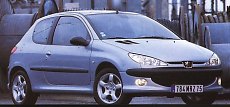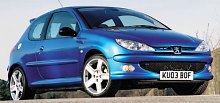206 S16 (GTi)
 "We’ve
built a modern GTi." "We’ve
built a modern GTi."
I heard this
slogan times
and times. Every time Volkswagen said it, a more refined, less exciting
and heavier Golf GTi was born. It made me hate of hearing this
slogan.
Finally, our King
of Handling,
Peugeot, has to say it. From the very beginning, even months before the
launch, Peugeot was telling the journalists not to expect a come back
of
the mighty 205GTi. It said the hot hatch 206, called S16 in France and
GTi in elsewhere, would provide the refinement and comfort that today’s
buyers want rather than concentrating solely on driving fun. Well, it
sounds
to be another boring Golf IV GTi ....
Thanks God ! it
isn’t. It
is actually a wolf in sheep’s skin. All the driving excitement and
involvement
is retained at 106 GTi and 306 GTi’s level, although the 205 die-hard
lovers
are unlikely to be contented. To understand the latest Peugeot bend
killer,
you have to look from the outside : -
One can hardly
distinguish
a 206 GTi from the lesser 206s. Apart from the marginally deeper chin
spoiler
and larger fog lamps, the GTi differs from the standard car by just the
15in alloy wheels. Yet 15 inches isn’t a big size, thus there is still
considerable space left between the wheels and the fenders, making the
GTi no more sportier than any ordinary 206s. This also indicate that
Peugeot
deliberately built more suspension travel, thus more ride comfort, into
it. As you might expect to see the "wolf" under the bonnet, you’ll once
again disappointed. The new GTi has got a new engine, but just the one
already appeared in any standard 406 sedans, that is, a 1997c.c. dohc
four
cylinder inline with 16 valves. Just like the specifications, maximum
output
of 137hp and 140lbft makes no surprise.
Compare with the
older engine
in 306GTi, it lost the variable length manifold and an amazing 30hp.
Well,
comments used to say the 306 seemed not to be so powerful. Perhaps this
time PSA give the new engine a more honest appraisal. On road, the
engine
feels powerful and torquey enough, also smooth and linear.
Rev-happy
is not its nature, as shown by the conservative 6500rpm red line.
Undoubtedly,
it’s not in the league of Alfa twin spark or Honda VTEC, but bearing in
mind it is the standard mass production unit and you’ll accept it.
Anyway,
it cope well with the 1050kg weight, capable of launching the hot hatch
to 62mph in 8.4sec, claimed Peugeot. The only real complain is the lack
of characterful noise.
Gearbox is less
happy. It
is exactly the same 5-speed manual as other 206s, gearchange is quite
notchy
and the throw is too long. Compare with the 306, it lost one ratio thus
every gear ratio separates farther from each other. Of course this
won’t
help performance as well as driving pleasure.
Climbed abroad,
the wolf
tail shows : aluminium gear knob, aluminium panel over console and
drilled
alloy pedals. Otherwise remain unchanged, this means the trip computer,
automatic climate control, optional satellite navigation and other
equipments
are not mutually exclusive against driving fun. Now I understand the
meaning
of "We’ve built a modern GTi." Steering wheel is adequately sized and
nice
to touch, this undoubtedly aid the remarkable control to be mentioned
later.
On the down side, the front seats are not too supportive and they are
positioned
too high, the latter are the result of high bonnet line.
Drive it around
town, you’ll
discover the steering is heavy while ride is much harder than other
206s.
As speeds increase the steering comes alive, weighting is just a
perfect
balance between confidence and convenience. Enter the first bend and
you’ll
think of a 306GTi, no, the 306 has never been so nimble ! It is much
more
like a 106GTi, just has more punch on tap and far more ride comfort.
In normal
condition it steers
neutrally, understeer won’t occur until the front wheels exceed their
limits
and spin, where back off the throttle could easily correct. Yes, few
front-wheel-drive
car has such a high level of throttle adjustability, not even its
brothers.
The secret is the communicative steering wheel helps the driver to feel
precisely when to engage and disengage the throttle. When rubbers are
gripping
hard on road surface, the steering feels meaty and positive. When the
car
is reaching the cornering limit, that is, tyres are riding on their
edge,
the steering lightens. It is these information tells the whole picture.
Besides, adequate amount of body roll also contributes to communication.
Lighter front
axle load is
probably another secret. Normally, the lighter the front end, the less
understeer generates (for a FF car). That’s why the new engine has
aluminium
alloy block.
The suspensions
engineers
in Peugeot really worth praising. Who knows the art of suspension
tuning
more than them ? since the 205, we’ve seen 309, 405, 605, 106, 306 and
406 stormed the world with their handling. 206 GTi is the newest
element
of the list, not only handles fabulously, it simultaneously delivers
refinement
at Golf’s level. The suspensions and steering filter bump and shock
effectively,
straight line stability is also remarkable. Therefore we can say it is
the best GTi in today.
How does it
compare with
the mighty 205 ? It’s like comparing a road car with a race car.
Tighten
the suspensions, stripped out 150kg, the race car will be knife sharp,
very alert to every little input. It won’t forgive your fault, too.
|
 Superminis
never come as beautiful as this one ! Look at the aggressive cat's
eyes,
the steeply sloping windscreen, the stylish nose and mouth ..... it is
simply a perfect design. Surprisingly, this kind of great designs often
come from Pininfarina studio, but this is a rare exception. It was
styled
inhousely.
Superminis
never come as beautiful as this one ! Look at the aggressive cat's
eyes,
the steeply sloping windscreen, the stylish nose and mouth ..... it is
simply a perfect design. Surprisingly, this kind of great designs often
come from Pininfarina studio, but this is a rare exception. It was
styled
inhousely.
 "We’ve
built a modern GTi."
"We’ve
built a modern GTi."
 What
an attractive car. The 206 hatchback is already the most beautiful
small
car on sale, with a beautifully crafted foldable roof it is even more
attractive.
Think about it, for a price of a hot hatch you can experience what made
Mercedes SLK so popular and unique during the last 5 years.
What
an attractive car. The 206 hatchback is already the most beautiful
small
car on sale, with a beautifully crafted foldable roof it is even more
attractive.
Think about it, for a price of a hot hatch you can experience what made
Mercedes SLK so popular and unique during the last 5 years.
 4
years ago we were happy with Peugeot 206 GTI, but time has changed and
today we have many faster and more exciting hot hatches - to name a
few,
Civic Type R, Mini Cooper S, Clio RS and more so the lightweight Clio
Cup.
The little Peugeot was suddenly outclassed. To strike back, Peugeot
teamed
up with Lotus to develop a hotter 206 called RC, or GTI 180 for the UK
market. Can it beat the oppositions? we'll find out...
4
years ago we were happy with Peugeot 206 GTI, but time has changed and
today we have many faster and more exciting hot hatches - to name a
few,
Civic Type R, Mini Cooper S, Clio RS and more so the lightweight Clio
Cup.
The little Peugeot was suddenly outclassed. To strike back, Peugeot
teamed
up with Lotus to develop a hotter 206 called RC, or GTI 180 for the UK
market. Can it beat the oppositions? we'll find out...